A basic understanding of theory can inform practice and improve understanding of the communities we work in.
Maslow's hierarchy of needs (1943)
Think about toast, it seems like nothing yet if you've ever given it out at a youth group you know people go crazy for it but say you're working with someone and they are struggling to feed themselves or their family is struggling. Then what does toast mean. It means a lot more, its not much but it is something.
As a community volunteer you should try to meet needs where you can even if its just a piece of toast or a safe place to go or somewhere you can feel part of a community.
These things all matter.
Basic needs then safety then community then individuality then we see the best in people.
"Tell me and I forget. Teach me and I remember. Involve me and I learn."
-Benjamin Franklin
As community volunteers it is within our power to create experiences and opportunities to learn in non-traditional environments. (Kolb,1984)
A trip to the beach could inspire a love of sea creatures or begin an understanding of the effects of plastic on ocean wildlife. Maybe then they attend a protest or start asking questions. Imagine they did! And those questions led to answers which meant that person did well in biology or joined a college course to learn more, maybe they didn't and that person became determined to find answers or create solutions. That's how everything starts.
If we nurture curiosity where we find it then it will grow.
Tuckman's theory of group development (1965) explains the stages groups go through in order to become effective. The theory can be applied to any group-work setting and gives an insight to how people work together.
A group has been working together for a week and last week they were all quite shy but this week everyone is arguing. Team members constantly disagree and nobody seems to be in charge. The next week everyone is friends with each other and have a clear team leader.
What happened?
Johari's window (1955) describes how people become closer and build trust.
Someone you work with tells you they like crochet but they aren't that good. So you get in crochet supplies and they make an amazing teddy bear with a funny nose that's full of character and you say "that's amazing, you don't give yourself enough credit". So they believe you and have the confidence to donate some teddy's to the local children's hospital where they are appreciated. Then they start teaching others and you find out this person who thought a wonky nose made a bad teddy is a great teacher. You should tell them.
Erik Eriksons 8 stages of development gives an indication of the challenges people may be facing at different times in their lives.
At each stage there is a potential positive outcome and a potential negative outcome, an understanding of these stages can help develop our understanding of the people we work with. It can help identify areas where more work is required than with others.
Imagine you have 10 young people walk into a centre and 9 of them trust you immediately but one is reticent. Later you find out that young person was taken into care when they were young and it seems safe to assume they won't trust easily. Over time with consistency and care the young person trusts you, this trust then encourages them to participate and excel since they are in a safe environment.
